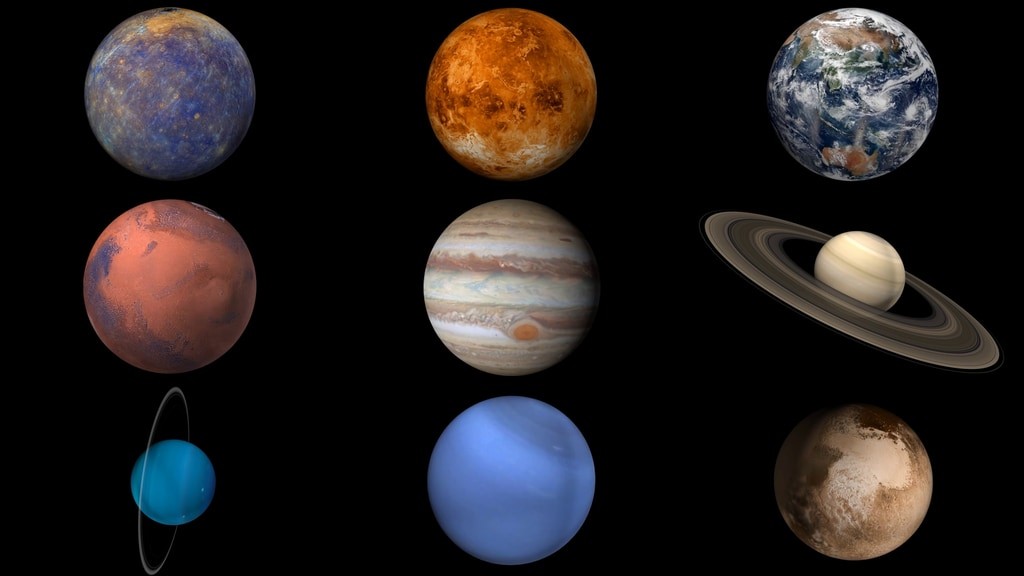Uranus Compared To Earth reveals striking differences in size, atmosphere, and more. COMPARE.EDU.VN provides an in-depth look at these celestial bodies, offering a clear understanding of their unique characteristics. Delve into a comprehensive planet comparison and explore space facts with us.
1. Introduction to Uranus and Earth
Uranus, the seventh planet from the Sun, is an ice giant vastly different from our home planet, Earth. Understanding the differences between Uranus and Earth provides valuable insights into planetary science and the diverse conditions found in our solar system. Uranus compared to Earth showcases how unique our own planet truly is. This comparison is designed for space enthusiasts, students, and anyone keen on understanding the distinct attributes of these two worlds.
1.1. What Makes Uranus Unique?
Uranus is an ice giant known for its unique axial tilt, causing it to rotate nearly on its side. This extreme tilt results in seasons that last for decades. Uranus is composed mainly of ice and gas, with a relatively small rocky core. Its atmosphere is predominantly hydrogen and helium, with traces of methane, which gives the planet its distinctive blue-green hue.
1.2. The Familiarity of Earth
Earth, on the other hand, is a terrestrial planet characterized by its rocky surface, diverse ecosystems, and abundant liquid water. Earth supports a wide range of life forms and has a nitrogen-oxygen atmosphere. Its stable axial tilt results in predictable seasons that are vital for agriculture and many other aspects of human civilization.
2. Size Comparison: Uranus vs. Earth
One of the most apparent differences between Uranus and Earth is their size. Uranus is significantly larger than Earth, with a much greater volume and mass. This size disparity impacts various other characteristics, including gravity, atmospheric pressure, and overall planetary dynamics.
2.1. Diameter and Volume
Uranus has an equatorial diameter of approximately 31,763 miles (51,118 kilometers), about four times the diameter of Earth, which is around 7,918 miles (12,742 kilometers). In terms of volume, Uranus is roughly 63 times larger than Earth, meaning you could fit 63 Earths inside Uranus.
2.2. Mass and Density
Despite its larger size, Uranus is less massive than one might expect. Uranus has about 14.5 times the mass of Earth. The density of Uranus is significantly lower than Earth’s, which has a density of 5.51 g/cm³. Uranus’s lower density is due to its composition, primarily made up of lighter elements such as hydrogen, helium, and ice.
3. Orbital Characteristics: Distance, Rotation, and Orbit
The orbital characteristics of Uranus differ significantly from those of Earth, influencing the planet’s seasons, day length, and overall climate. Understanding these differences provides a deeper appreciation for the unique environments on each planet.
3.1. Distance from the Sun
Uranus orbits the Sun at an average distance of about 1.8 billion miles (2.9 billion kilometers), or 19 astronomical units (AU). This is vastly farther than Earth’s average distance of 93 million miles (150 million kilometers), or 1 AU. The immense distance from the Sun results in significantly lower solar radiation reaching Uranus.
3.2. Rotation and Day Length
One day on Uranus lasts approximately 17 hours, which is shorter than Earth’s 24-hour day. However, Uranus’s unique axial tilt dramatically affects its day and night cycle, particularly at the poles.
3.3. Orbit and Year Length
Uranus takes about 84 Earth years to complete one orbit around the Sun. This extended orbital period means that each season on Uranus lasts around 21 Earth years. Earth completes its orbit in approximately 365.25 days, resulting in much shorter and more predictable seasons.
4. Atmospheric Composition: Gases and Climate
The atmospheres of Uranus and Earth are vastly different, leading to contrasting climates and surface conditions. Understanding the atmospheric composition helps explain the unique characteristics of each planet.
4.1. Atmospheric Gases on Uranus
Uranus’ atmosphere is primarily composed of hydrogen and helium, with a small amount of methane. The methane absorbs red light, giving Uranus its blue-green appearance. Traces of water and ammonia are also present.
4.2. Climate and Weather Patterns
The atmosphere of Uranus experiences extreme weather patterns, including high-speed winds that can reach up to 560 miles per hour (900 kilometers per hour). Despite its cold temperatures, Uranus exhibits dynamic cloud activity, particularly as it approaches equinox. Uranus’ atmospheric temperature can reach as low as -224.2 degrees Celsius.
4.3. Earth’s Atmosphere and Climate
Earth’s atmosphere is composed mainly of nitrogen (78%) and oxygen (21%), with trace amounts of other gases, including carbon dioxide, argon, and water vapor. This composition supports life and helps regulate the planet’s temperature. Earth’s climate is diverse, with distinct regions experiencing a wide range of weather patterns.
5. Internal Structure: Core, Mantle, and Layers
The internal structures of Uranus and Earth reveal fundamental differences in their composition and formation. These internal characteristics influence the planets’ magnetic fields and overall geological activity.
5.1. Uranus’ Internal Layers
Uranus is believed to have a small rocky core surrounded by a hot, dense fluid of icy materials, including water, methane, and ammonia. This icy mantle makes up the majority of the planet’s mass.
5.2. Earth’s Internal Structure
Earth has a layered structure consisting of a solid inner core, a liquid outer core, a mantle, and a crust. The core is primarily made of iron and nickel, while the mantle is composed of silicate rocks. The crust is the outermost layer, consisting of both oceanic and continental crust.
6. Surface Conditions: Temperature and Landscape
The surface conditions of Uranus and Earth are dramatically different, reflecting the distinct atmospheric compositions and distances from the Sun.
6.1. Uranus’ Lack of a True Surface
Uranus does not have a true surface like Earth. It is primarily composed of swirling fluids. The extreme pressures and temperatures in Uranus’ atmosphere would destroy any spacecraft attempting to penetrate it.
6.2. Temperature Extremes
The temperature in Uranus’ atmosphere can drop to a minimum of 49K (-224.2 degrees Celsius), making it one of the coldest places in our solar system. These extreme temperatures are due to the planet’s distance from the Sun and its atmospheric composition.
6.3. Earth’s Varied Landscapes
Earth has a diverse range of landscapes, including mountains, deserts, oceans, and forests. These landscapes support a wide variety of ecosystems and life forms. Earth’s surface temperature varies widely depending on location and season, but it generally ranges from -88 to 58 degrees Celsius.
7. Moons and Rings: Satellite Systems
Both Uranus and Earth have satellite systems, but their compositions and characteristics differ significantly. Uranus has a complex system of moons and rings, while Earth has a single, large moon.
7.1. Uranus’ Moons
Uranus has 28 known moons, named after characters from the works of William Shakespeare and Alexander Pope. The inner moons are composed of roughly half water ice and half rock. The outer moons are likely captured asteroids.
7.2. Rings of Uranus
Uranus has a complex ring system consisting of 13 distinct rings. The inner rings are mostly narrow and dark grey, while the outer rings include a reddish dusty ring and a blue ring similar to Saturn’s E ring.
7.3. Earth’s Moon
Earth has a single, large moon that is believed to have formed from debris resulting from a collision between Earth and a Mars-sized object early in the solar system’s history. The Moon influences Earth’s tides and helps stabilize its axial tilt.
8. Magnetosphere: Magnetic Field Characteristics
The magnetospheres of Uranus and Earth differ significantly in their orientation and strength, influencing how each planet interacts with the solar wind.
8.1. Uranus’ Unusual Magnetosphere
Uranus has an irregularly shaped magnetosphere. The magnetic axis is tilted nearly 60 degrees from the planet’s axis of rotation and is offset from the center of the planet by one-third of the planet’s radius. This unusual orientation results in auroras that are not aligned with the poles.
8.2. Earth’s Magnetosphere
Earth has a strong and relatively stable magnetosphere that is aligned with the planet’s rotation. This magnetosphere protects Earth from harmful solar wind and cosmic radiation. The interaction between the solar wind and Earth’s magnetosphere causes auroras, also known as the Northern and Southern Lights.
9. Potential for Life: Habitability Factors
The potential for life on Uranus and Earth differs dramatically due to their distinct environmental conditions. Earth is teeming with life, while Uranus is considered uninhabitable.
9.1. Habitability of Uranus
Uranus’ environment is not conducive to life as we know it. The extreme temperatures, pressures, and materials that characterize this planet are likely too extreme for organisms to adapt to.
9.2. Earth’s Life-Supporting Conditions
Earth supports a wide range of life forms due to its moderate temperatures, abundant liquid water, and protective atmosphere. The presence of oxygen and a stable climate makes Earth uniquely habitable.
10. Discoveries and Exploration: Space Missions
The exploration of Uranus and Earth has been conducted through various space missions, providing valuable data and insights into these planets.
10.1. Past Missions to Uranus
The Voyager 2 mission is the only spacecraft to have flown by Uranus, providing valuable data about its atmosphere, moons, and rings. There are ongoing discussions about future missions to Uranus to further explore this ice giant.
10.2. Earth’s Exploration Efforts
Earth has been extensively explored through numerous space missions, including the Apollo missions to the Moon and various satellite missions studying Earth’s climate, geology, and environment.
11. Unique Characteristics: Axial Tilt and Composition
Uranus and Earth both possess unique characteristics that set them apart from other planets in our solar system.
11.1. Uranus’ Extreme Axial Tilt
Uranus is the only planet in our solar system with an axial tilt of nearly 98 degrees, causing it to rotate on its side. This extreme tilt results in unique seasonal patterns.
11.2. Earth’s Geological Activity
Earth is unique among the planets in our solar system for its active plate tectonics. This geological activity shapes Earth’s surface and influences its climate and environment.
11.3. Compositional Differences
Uranus is primarily composed of ice and gas, while Earth is a terrestrial planet made of rock and metal. This difference in composition influences the density, internal structure, and surface conditions of each planet.
12. Future Research and Missions: What’s Next?
Future research and missions to Uranus and Earth promise to unveil even more about these fascinating planets.
12.1. Potential Future Missions to Uranus
Scientists are considering potential future missions to Uranus to study its atmosphere, moons, and rings in greater detail. These missions could provide new insights into the formation and evolution of ice giants.
12.2. Ongoing Research on Earth
Ongoing research on Earth includes studying climate change, monitoring ecosystems, and exploring the planet’s geology and oceans. These efforts aim to better understand and protect our home planet.
13. Comparative Table: Uranus vs. Earth
| Feature | Uranus | Earth |
|---|---|---|
| Equatorial Diameter | 31,763 miles (51,118 km) | 7,918 miles (12,742 km) |
| Mass (Earths) | 14.5 times Earth’s mass | 1 Earth mass |
| Distance from Sun | 1.8 billion miles (2.9 billion km) or 19 AU | 93 million miles (150 million km) or 1 AU |
| Day Length | 17 hours | 24 hours |
| Year Length | 84 Earth years | 365.25 days |
| Atmosphere | Hydrogen, helium, methane | Nitrogen, oxygen |
| Surface | No true surface | Solid, varied landscapes |
| Moons | 28 | 1 |
| Rings | 13 | None |
| Magnetosphere | Irregularly shaped | Stable |
| Potential for Life | Uninhabitable | Habitable |
| Axial Tilt | 98 degrees | 23.5 degrees |


14. Key Takeaways: Understanding the Differences
Understanding the differences between Uranus and Earth provides valuable insights into planetary science and the diverse conditions found in our solar system.
14.1. Contrasting Worlds
Uranus and Earth represent contrasting worlds, with vastly different sizes, atmospheres, and surface conditions. Studying these differences helps scientists understand the processes that shape planets and their environments.
14.2. The Uniqueness of Earth
The comparison between Uranus and Earth highlights the unique conditions that make our planet habitable. Earth’s moderate temperatures, abundant liquid water, and protective atmosphere support a wide range of life forms.
15. Frequently Asked Questions (FAQ)
15.1. What is the size difference between Uranus and Earth?
Uranus is about four times wider than Earth in diameter and approximately 63 times larger in volume.
15.2. How long is a year on Uranus?
A year on Uranus is about 84 Earth years.
15.3. What is Uranus made of?
Uranus is primarily made of ice and gas, with a small rocky core.
15.4. Does Uranus have a surface?
No, Uranus does not have a true surface; it is mainly composed of swirling fluids.
15.5. How many moons does Uranus have?
Uranus has 28 known moons.
15.6. Why is Uranus blue?
Uranus appears blue due to the methane in its atmosphere, which absorbs red light.
15.7. What is the temperature on Uranus?
The minimum temperature on Uranus can reach -224.2 degrees Celsius.
15.8. Has a spacecraft visited Uranus?
Yes, Voyager 2 is the only spacecraft to have flown by Uranus.
15.9. What is the axial tilt of Uranus?
Uranus has an axial tilt of nearly 98 degrees, causing it to rotate on its side.
15.10. Can life exist on Uranus?
No, Uranus’ environment is not conducive to life as we know it due to extreme temperatures and pressures.
16. Conclusion: Discover More with COMPARE.EDU.VN
Understanding the comparison between Uranus and Earth enriches our knowledge of planetary science. By examining the size, atmosphere, and other characteristics of these two celestial bodies, we gain a deeper appreciation for the diversity of worlds in our solar system.
Are you struggling to compare different options and make informed decisions? At COMPARE.EDU.VN, we provide detailed and objective comparisons to help you make the right choices. Whether you’re comparing products, services, or ideas, our platform offers comprehensive insights to simplify your decision-making process. Visit COMPARE.EDU.VN today and discover the ease of making smart choices.
Address: 333 Comparison Plaza, Choice City, CA 90210, United States
WhatsApp: +1 (626) 555-9090
Website: COMPARE.EDU.VN
Remember, making informed decisions is easier with compare.edu.vn!

